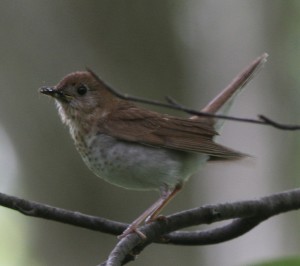A Veery’s Two Voices

As a kid, I began learning to identify bird sounds by listening to the old Peterson Birding By Ear tapes (one of the best learning aids in existence for bird song, still on the market in CD form). One part of the tape eventually wore through because I listened to it so often — the part with the Veery.
What made that part so special was that Birding By Ear played the Veery song several times — first at normal speed, and then slowed down to half and quarter speed. At full speed, the song was incredible: a shimmering swirl of notes spiralling downward, ethereal and metallic. Slowed down, it was more incredible still. The bird’s voice rolled up and down arpeggios like someone playing pan pipes — two people playing pan pipes, actually, because the Veery is a polyphonic singer; it sings simultaneously with both sides of its syrinx. The bird literally has two voices, one from each of its lungs, and it can control them separately. A single Veery sings a duet — and when you slow the song down, you can hear the bird actually harmonize with itself.
Today, I can recreate those slowed-down Veery songs on the computer. And I can take it one step further: I can undo the duet. I can edit the sound file so as to listen to one Veery voice at a time.
The original
Here’s one strophe of a Veery song from Colorado. I’ve cleaned up the spectrogram to show how the two voices overlay one another. (Not my best photo editing, but it’ll have to do.)

If you’re familiar with the Veery’s song from the eastern United States, you might find this example slightly less ethereal, slightly more jangling, and slightly less shimmery than the versions you’re used to hearing. For the most part, that’s not actually due to geographic differences in Veery song (although there are some of those as well). It’s mostly due to the fact that eastern Veeries almost always sing in hardwood forests, where their voices bounce off of innumerable trunks and leaves, smearing the sound with echo. The Veery I’ve chosen, like most in Colorado, sings in willow carrs at medium-high elevation — a much more open habitat that lacks a forest’s echo. It may make the Veery a little less evocative, but it makes it much easier for me to do the sound editing necessary to separate the voices from one another.
Now let’s slow the Veery down, so you can hear it harmonizing with itself:
half speed:
1/4 speed:
Separating the voices
Here’s what the spectrogram of the Veery song looks like if we make the two voices different colors:

And here they are, separated to the best of my ability. (The first note, the rising single-voiced burr, is on both recordings.)
Upper voice (red):
Lower voice (cyan):
Having trouble following along? Try listening to both voices at half speed:
Upper voice (red) at half speed:
Lower voice (cyan) at half speed:
What can we learn from this exercise? First, the upper voice dominates the original song. It’s carrying the melody; the lower voice is softer and just provides the harmony. Second, the level of detail in each voice is immense, and can be difficult to follow even at half speed. Third, both voices are needed to bring out the jangling, metallic quality that is so typical of Veery and its relatives. That metallic sound is an emergent property of the two voices mixing. More on that in a future post.
Finally, and most importantly: bird sounds are really, really freakin’ cool. But I bet most of you knew that already.
5 thoughts on “A Veery’s Two Voices”
Holy cow, this is amazing and beautiful! In central Texas we only occasionally get to hear a thrush song, usually a Swainson’s Thrush during spring migration. How did you separate the two songs?
I used bandwidth filters in an audio editing program to edit out the lower voice, one note at a time, leaving just the upper voice. Then I went back to the original and did it the other way around. Neat, huh?
Wonderful – the description, too. Today I was listening to a veery out here in Washington state, along a trail that cuts through agricultural land. I’m from the northeast, and your explanation of the difference between hearing birdsong in dif habitats is very interesting
Nice! Raven Lite?
Actually, I use Raven Pro. But Raven Pro isn’t meant to be a high-quality sound editor — I could have performed the same function more quickly and easily using something like Adobe Audition.
Nothing beats Raven for creating spectrograms, though.
Comments are closed.